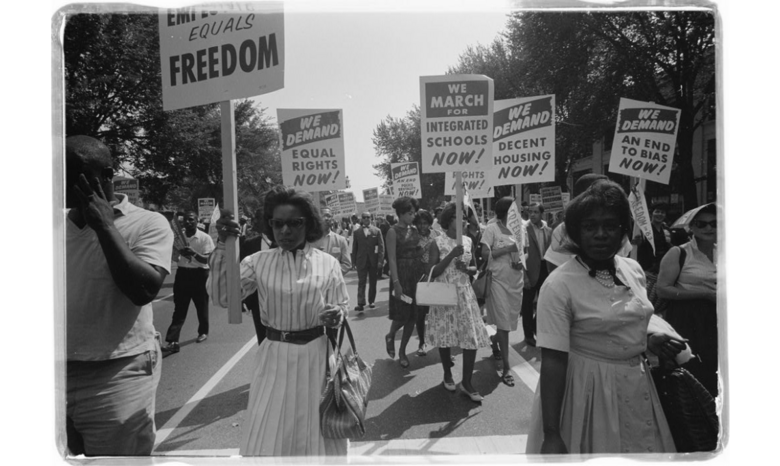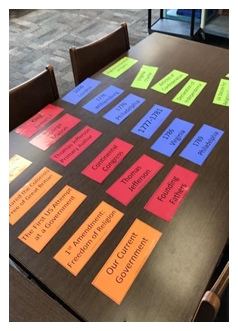- Author:
- Woodson Collaborative, Lillian Allen-Brown
- Subject:
- History/Social Sciences, American History, Government and Civics, Virginia History
- Material Type:
- Lesson
- Level:
- Middle School, High School
- Tags:
- License:
- Creative Commons Attribution Non-Commercial
- Language:
- English
- Media Formats:
- Downloadable docs, Interactive
Education Standards
Civil Rights Sorting cards
Civil Rights STUDENT PAGE
One Move Game
Civil Rights Sorting Cards

Overview
Students will match the name, phrases and picture. The cards focus on the specific VDOE SOL essential knowledge, adapts to the required SOL 1 Primary resource learning components, and activates the multiple learning styles. The Task Cards allow multiple SOL strand concept review. The teacher can use them in a small group, tiered groupings, and independent study.
INSTRUCTOR PAGE
US History II / 7th grade or Secondary History
Author: Lillian Allen-Brown (Portsmouth Public School)
Task Overview: Students will match the name, phrases and picture. The cards focus on the specific VDOE SOL essential knowledge, adapts to the required SOL 1 Primary resource learning components, and activates the multiple learning styles. The Task Cards allow multiple SOL strand concept review. The teacher can use them in a small group, tiered groupings, and independent study.
See attached files:
Civil Rights Sorting Cards
One Move Game (allows full classroom participation)
Targeted SOLs:
USII.1 The student will demonstrate skills for historical thinking, geographical analysis, economic decision making, and responsible citizenship by
a) analyzing and interpreting artifacts and primary and secondary sources to understand events in United States history
USII.9a The student will apply social science skills to understand of the key domestic and international issues during the second half of the twentieth and early twenty-first centuries by
a) examining the impact of the Civil Rights Movement, the Americans with Disabilities Act (ADA), and the changing role of women on all Americans;
Know (facts) | Understand (concepts) | Do (skills) |
VDOE SOL USII.9a Some effects of segregation ●Separate and unequal educational facilities and resources ●Separate and unequal public facilities (e.g., restrooms, drinking fountains, restaurants) ●Segregated and disadvantaged neighborhoods ●Exclusion from well-paying jobs ●Undermining of wealth building by low property values in segregated neighborhoods ●Unpunished violence against African Americans Civil Rights Movement ●Opposition to Plessy v. Ferguson: “Separate but equal” ●Student walkout of 1951 at Moton High School led by Barbara Johns ●Brown v. Board of Education: Desegregation of schools ●Killing of Emmett Till in Mississippi became a national scandal because of the photographed open casket ●Martin Luther King, Jr.: Passive resistance against segregated facilities; “I have a dream…” speech ●Rosa Parks: Montgomery bus boycott ●Organized protests, Freedom Riders, sit-ins, marches, boycotts ●Bombing of churches and homes by white opponents of the Civil Rights movement ●Expansion of the National Association for the Advancement of Colored People (NAACP) ●Civil Rights Act of 1964: Prohibited segregation in public places and banned employment discrimination based on race, color, religion, gender, or national origin ●Voting Rights Act of 1965: Banned the use of literacy tests and provided for federal oversight of voter registration. | VDOE SOL USII.9 The Civil Rights Movement of the twentieth century was committed to equal rights and fair treatment of African Americans, but it resulted in social, legal, political, and cultural changes that prohibited discrimination and segregation for all Americans. Other activists were inspired by the achievements of the Civil Rights Movement and took action to gain equality.
| VDOE SOL USII.1a Primary and secondary sources enable us to examine evidence closely and to place it in a broader context. A secondary source is a document, image, or other source of information that relates or discusses information originally presented elsewhere. Analyzing and interpreting includes identifying the important elements of information sources in order to make inferences and generalizations and draw conclusions. Experiences may include but are not limited to the following: ● Use an analysis tool to analyze and interpret artifacts and primary and secondary sources. Sample Analysis Tool Title of Informational Source: Key Elements Evidence Observation: What do you see? Source: Who created the source? Context: Where is the source located in terms of time and place? Historical Perspective: Whose point of view does the source represent? Analysis: What is the source’s impact on history?
|
Instructor Directions: The use of sorting cards allows the educator immediate formative assessment through observation. You can use dollar store baskets for station holders. The sorting cards work great in tiered / strand learning centers, checking for understanding, rollbacks reviews, test prep, or to promote no worksheet instructional classroom sessions. This activity integrates several learning styles in the classroom instruction. On the left, I added magnets and played my “One Move Game” in teams of 2 for full classroom participation.
STUDENT PAGE
Directions: The students will match the image, phrase and name.
One Move example:
By the Dr. Carter G. Woodson Collaborative, 2021
Cover photo credit: Library of Congress



